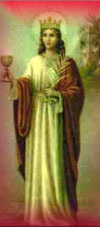|
It is
estimated that between 527,828 and 702,000 African
slaves were brought into Cuba between the 16th and
19th centuries (Murphy 1993:23).
The majority of them were to be used to work the
sugar and tobacco plantations where labor was
grueling and the hours were long and without
respite. Catholicism was the legal religion as
Cuba was controlled by Spain, and the slaves were
converted to the state religion, if only
superficially. In general, slaves were
baptized and required to attend Sunday mass and holy
days of obligation (Valdez-Cruz 1977:246).
They did not receive catechism or any serious
education about the faith. The
prevailing sentiment was that to provide the slaves
education about Catholicism would inevitably cause
revolt due to the inhuman way they were treated.
This tacit enforcement of conversion is, perhaps,
one of the most significant factors in the success
of the African slaves ability to retain the faith
that they had brought with them from their homeland.
Literally translated, Santería
means "the way of the saints." Scholars,
notably Melville Herskovits, refer to Santería
as an example of syncretism, which Joseph Murphy
describes as "a mixture of religious ideas without
an inner integrity" (1993:120). This
interpretation may be too superficial, intimating
that Catholicism and the religion the slaves brought
with them were blended. He goes on to
argue that "by seeing the process as a fusion of
religious ideas, Herskovits misses the creative and
self-conscious decisions that underly santería
syncretism (1993:121). Santería is not simply
the result of the slaves' transculturation; I
believe that it is more an adaptation to maintain
their faith.
 In the religion that the Yoruba
brought with them across the Middle Passage and into
the New World, it is believed that the orishas have
different paths or caminos as they would come
to be called; the Spanish word for "road".
African slaves were more or less using the
representations of the Catholic saints to conceal
the practice of their own religion from the prying
eyes of their masters and the Catholic Church. They found
commonalities between the Catholic saints and their
own orishas and treated the icons as another face of
the orisha they were already familiar with.
For example, the orisha Babalú Ayé, the orisha
associated with illness, was identified with
Lazarus whom Jesus raised from the dead in the
Bible. Yemaya, the mother of the orishas, was
associated with the Virgin Mary, the mother of
Jesus. The popular orisha Shangó, who was a
great warrior, became identified with Saint Barbara
(At left. Image from
http://altreligion.about.com/library/graphics/bl_chango.htm) who was often depicted with a
red cloak and sword. As a
result, the orishas were now also referred to as
santos, saints. Raul Canizares, a santero
himself, notes that "it does not matter by what
Catholic name the orishas are called, as long as
those who need to know are aware of the identity of
the orisha being honored behind the Catholic facade"
(1999:41). In the religion that the Yoruba
brought with them across the Middle Passage and into
the New World, it is believed that the orishas have
different paths or caminos as they would come
to be called; the Spanish word for "road".
African slaves were more or less using the
representations of the Catholic saints to conceal
the practice of their own religion from the prying
eyes of their masters and the Catholic Church. They found
commonalities between the Catholic saints and their
own orishas and treated the icons as another face of
the orisha they were already familiar with.
For example, the orisha Babalú Ayé, the orisha
associated with illness, was identified with
Lazarus whom Jesus raised from the dead in the
Bible. Yemaya, the mother of the orishas, was
associated with the Virgin Mary, the mother of
Jesus. The popular orisha Shangó, who was a
great warrior, became identified with Saint Barbara
(At left. Image from
http://altreligion.about.com/library/graphics/bl_chango.htm) who was often depicted with a
red cloak and sword. As a
result, the orishas were now also referred to as
santos, saints. Raul Canizares, a santero
himself, notes that "it does not matter by what
Catholic name the orishas are called, as long as
those who need to know are aware of the identity of
the orisha being honored behind the Catholic facade"
(1999:41).
Whatever the true reason behind
their actions, the African slaves were successful in
keeping alive the religion they had brought with
them. They were allowed to venerate and praise
their orishas, however covertly. The dances and music that were
integral parts of such ceremonies were alive and
well in Cuba and would eventually make their way to
the United States. |